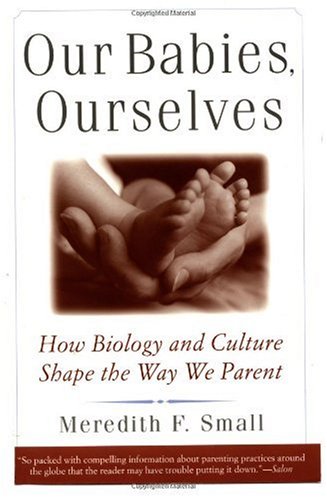Crying as an Evolutionary Strategy
Crying evolved to serve the infant's purposes: to assure protection, adequate feeding, and nurturing for an organism that cannot care for itself. By definition, crying is designed to elicit a response, to activate emotions, to play on the empathy of another. The "other" is usually the mother or father or a related caretaker. The caretaker has also evolved the sensory mechanism to recognize that infant cries are a signal of unhappiness, and thus be motivated to do something about it.
This kind of symbiotic relationship certainly made sense in the EEA. Even back then we were a large-brained species whose infants had to be born early in their physical development because of the constraints of the bipedal pelvis. As a result, human babies could not yet talk and thus had to communicate by other means. In the EEA, crying probably promoted survival because it kept the mother close, resulted in the infant's being fed as she held out the breast to quiet it, and kept parents attentive against predators. A quick cry, then, made evolutionary sense, at least in the EEA. At the most fundamental level, crying is an adaptive strategy because it keeps a baby alive and well fed and therefore ultimately passes on genes and improves a parent's reproductive success.
It might also have an added evolutionary advantage. When a baby is allowed to feed continuously, ovulation in the mother and conception of the next sibling who will take over breast-feeding is delayed. And so the combination of crying and the continuous feeding that results from crying is also an effective adaptive strategy on the part of the infant; infants who evolved with these traits had a better chance of survival than those who did not. In this scenario, the infant is not simply a helpless or passive recipient of parental largess, but an active initiator of a synergistic relationship with the parent.
In some cultures today, the fit between infant cries and survival has been altered and crying has become, as in the case of colic, a maladaptive trait that no longer promotes survival. Any trait can become maladaptive when the environment changes; what once was "good" now becomes neutral or "bad" because it is no longer effective under the new conditions. When crying is continual and annoying to the point of placing the infant in danger of abuse or neglect, it is a clearly maladaptive signal. And that may be what has happened in our modern age. It is not that babies have changed, but rather that the environment in which babies send their signals has been altered.
Notes:
Infants cry to motivate mothers to care for them and to promote continual feeding that prevents the mother from ovulating.
Folksonomies: evolution infancy adaptation crying
Taxonomies:
/family and parenting/babies and toddlers (0.406629)
/family and parenting/motherhood/pregnancy (0.353999)
/family and parenting/children (0.275192)
Keywords:
infant cries (0.964964 (negative:-0.471354)), Evolutionary Strategy Infants (0.883668 (negative:-0.845307)), clearly maladaptive signal (0.820725 (negative:-0.487275)), adaptive strategy (0.811879 (positive:0.626995)), effective adaptive strategy (0.752098 (positive:0.456213)), crying (0.693227 (positive:0.178586)), maladaptive trait (0.649561 (negative:-0.715688)), continual feeding (0.636999 (negative:-0.845307)), adequate feeding (0.618900 (neutral:0.000000)), bipedal pelvis (0.618143 (negative:-0.453797)), human babies (0.594539 (negative:-0.211339)), sensory mechanism (0.590066 (negative:-0.387261)), symbiotic relationship (0.587771 (positive:0.792881)), large-brained species (0.583179 (negative:-0.453797)), physical development (0.582512 (negative:-0.453797)), evolutionary advantage (0.581687 (positive:0.519894)), mother (0.580430 (negative:-0.619060)), evolutionary sense (0.577938 (neutral:0.000000)), modern age (0.572788 (neutral:0.000000)), active initiator (0.572773 (positive:0.356639)), promotes survival (0.572021 (negative:-0.715688)), fundamental level (0.566628 (positive:0.647413)), passive recipient (0.563201 (negative:-0.392399)), parental largess (0.562624 (negative:-0.392399)), synergistic relationship (0.558951 (positive:0.356639)), better chance (0.558705 (neutral:0.000000)), continuous feeding (0.556400 (positive:0.456213)), new conditions (0.550872 (negative:-0.579556)), environment changes (0.542452 (negative:-0.484651)), EEA (0.532781 (positive:0.439560))
Entities:
EEA:Organization (0.826764 (positive:0.219780)), colic:HealthCondition (0.364615 (negative:-0.649951))
Concepts:
Infant (0.977135): dbpedia | freebase | opencyc
Pregnancy (0.693110): dbpedia | freebase | opencyc
Parent (0.669124): dbpedia | freebase | opencyc
Breastfeeding (0.633048): dbpedia | freebase | yago
Evolution (0.604750): dbpedia | freebase | opencyc
Symbiosis (0.578305): dbpedia | freebase
Maternal bond (0.555899): dbpedia | freebase
Baby colic (0.553415): dbpedia | freebase | yago





